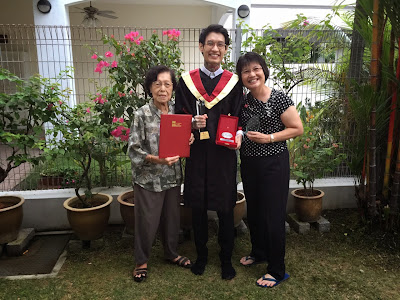Being Homeless for a Day
While Singapore might have achieved prosperity, there are still some homeless people in Singapore who are often invisible and forgotten. That is why we, a team of Year 3 students from the Diploma in Social Sciences (Social Work), decided to focus on the homeless for our Final Year Project (FYP).
Through several weeks, during the evenings, we reached out to the homeless living on the streets to find out more about their lives, social circumstances and living conditions. We also talked to social workers who work with the homeless to get their professional views and find out more about their experiences and the challenges they face in their work.
However, our surveys with members of the public showed that very few of them knew about the predicaments of the homeless, or how people can end up being homeless. Hence, we organised a one-day-one-night simulation programme for members of the public to step into the shoes of a homeless person. We publicized the event through our Home Without Shelter Facebook page and invited people to sign up for our programme there.
Our stay-over campaign was held at The Hiding Place, a halfway house at Jalan Lekar, on 18 and 19 July. It involved 19 participants and 11 volunteers. To allow participants to have a realistic sense of what it meant to be homeless, we had several exercises planned.
The day started with The Game of Life: Homeless Edition, an activity our FYP group painstakingly crafted.
Participants were put into different demographic groups, including the elderly, substance abusers, and others. They had to find jobs and earn money. But that quest was made harder by the �baggage� that weighed them down. Some of the �elderly�, for example, experienced arthritis through beans placed into their shoes, while others were slowed down by the weights tied to their legs. �Substance abusers� had ice poured into their shirts to simulate drug withdrawal symptoms.
Their choices of �jobs� were limited to low-paying ones, like begging, factory, administrative, cleaning and �Karang Guni� (rag and bone collectors) jobs. They could use the money they earned to buy food or drinks, or rent a shelter instead of having to sleep outdoors. They had to make choices, and sacrifices, just as the homeless do.
Each station can only take 1-2 participants at one time. Each job lasts 15 minutes. If all the stations are filled, participants can only be �beggars�, earning $5
It�s a race against time at the Admin job station! In order to receive their wages ($20), participants had to finish typing an article, consisting of more than 1000 words, in 15 minutes.
There were two factory-based simulation jobs at this station. The first was packing beans (using chopsticks) into a sachet ($15).
Hungry or thirsty? Participants could treat themselves at the �kopitiam� with the money they earned, but that meant that they won�t be able to afford shelter ($50 - $110), for the night.
The organising team had prepared dinner for the participants, which they had to pay "$6" for with the �money� they earned.
The participants ate and worked like real homeless people. They too, �experienced� similar feelings of rejection from �employers� and vulnerability to the environment.
After dinner, we screened two documentaries on the plight of the homeless in Singapore, including a self-produced documentary. The participants were then invited to write letters of encouragement to the homeless
.
Posted by Home Without Shelter on Tuesday, 28 July 2015
.
Then, the founder of Homeless Hearts of Singapore, Mr Abraham Yeo, came forward to talk about his passion for helping the homeless. He shared that the most valuable gift he could give them was friendship.
�Open your eyes. Slow down, sit down and talk to them. Walk together with them in their pain. Support them and encourage them to get back on their feet,� he said.
As the day came to a close, each participant was given a piece of cardboard to sleep on. Ironically, even the few who had earned enough to afford shelter decided to sleep on cardboard with the larger group. Why? Probably because if they slept in the shelter, they could not be together with the rest.
Just as charity organisations do food runs, we set up a welfare kitchen for our participants. Many were hungry due to the light dinner, and thus felt gratitude when we gave them food. Through this activity, we hope they could understand how it felt being on the receiving end of help, and saw the beauty in giving.
But the night was not over. It was almost 3am when our �police� woke them up.
In the wee hours of the morning, participants were awoken by our �police�, who later explained the reasoning behind this activity. Just as the homeless get awakened by the police, or evicted from public spaces, our participants experienced the same.
At 7.20am the next day, the simulated experience came to an end. After asking them how they felt, the participants shared that the exercises helped them to understand and empathise with the homeless better.
�I learnt what causes people to become homeless. It is important to prevent the problem from arising before it precipitates, as I cannot imagine being permanently homeless. I mean, living as a homeless person for a few hours is already so difficult, how about those who live like this for months, or maybe even years?� said Christopher Teo, a participant.
�Although the living conditions are tough in this event, we still have other �homeless� persons around us for mutual support. This led me to think about the homeless who have no one by their side, and I think social support is very important,� said Michelle Yap, another participant.
Find out more about the homeless by visiting our website Home Without Shelter.
By Matthew Tan Ser Yung, Diploma in Social Science (Social Work)
Matthew is 20 and pursuing his Diploma in Social Sciences (Social Work) at NYP. He may have suffered a traumatic brain injury in a judo competition and may have lost his hopes of becoming a judo champion, but he has found new passion and interest in writing. He is happy to share how he feels and thinks, and hopes to encourage his readers with his writing.

























Comments
Post a Comment